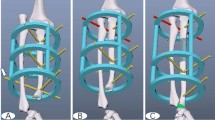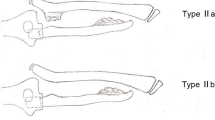Abstract
Background
Ulna distraction by monolateral external fixator (MEFix) is a good option for the treatment of Masada type I and IIb deformities in children with hereditary multiple exostoses (HMEs). However, there is no consensus regarding where to perform ulnar osteotomy. Our hypothesis is that osteotomy at the proximal third of the ulna and progressive distraction with MEFix can simultaneously correct elbow and wrist deformities in patients with HME.
Methods
We retrospectively reviewed patients with HME who underwent ulna distraction osteogenesis from June 2014 to March 2019. The carrying angle (CA), radial articular angle (RAA), ulnar variance (UV), radial variance (RV) and range of motion (ROM) of the affected forearm and elbow were clinically assessed before lengthening and at the last follow-up visit. The total ulna lengthening distance (LD) and radiographic outcome were also recorded.
Results
Nineteen patients (20 forearms) with HME aged 9.1 ± 2.4 years at the time of surgery were retrospectively reviewed. The mean follow-up period was 26.1 ± 5.6 months. There were 11 patients (12 forearms) with Masada type I deformities and eight patients (8 forearms) with Masada type IIb deformities. Patients with type IIb deformity had higher RV, lower CA values, less elbow flexion and forearm pronosupination than those with type I deformity (p < 0.05); RV was an independent risk factor for radial head dislocation, with the cut off at RV > 15.5 mm. The mean LDs in patients with type I and type IIb deformities were 33.6 ± 6.6 mm and 41.4 ± 5.4 mm, respectively. The mean CA, UV, RV, forearm pronation and ulna deviation at the wrist improved significantly following surgery in all patients. In particular, five of eight patients (62.5%) with type IIb deformities had concentric reduction of the radiocapitellar joint, while no radial head subluxation was detected in patients with type I deformities at the last follow-up. Three complications were recorded: two pin-track infections and one delayed union.
Conclusions
Distraction osteogenesis at the proximal third of the ulna provides satisfactory clinical and radiological outcomes in patients with Masada type I and IIb deformities. Early treatment of Masada type I deformities is indicated before progression to more complex type IIb deformities.




Similar content being viewed by others
References
Schmale GA, Conrad EU 3rd, Raskind WH (1994) The natural history of hereditary multiple exostoses. J Bone Joint Surg Am 76(7):986–992. https://doi.org/10.2106/00004623-199407000-00005
Solomon L. Bone growth in diaphysial aclasis (1961) J Bone Joint Surg Br, 43-B:700–16. https://doi.org/10.1302/0301-620X.43B4.700
Jones KB (2011) Glycobiology and the growth plate: current concepts in multiple hereditary exostoses. J Pediatr Orthop 31(5):577–586. https://doi.org/10.1097/BPO.0b013e31821c7738
Stieber JR, Dormans JP. Manifestations of hereditary multiple exostoses (2005) J Am Acad Orthop Surg, 13(2):110–20. https://doi.org/10.5435/00124635-200503000-00004.
Masada K, Tsuyuguchi Y, Kawai H, Kawabata H, Noguchi K, Ono K (1989) Operations for forearm deformity caused by multiple osteochondromas. J Bone Joint Surg Br 71(1):24–29. https://doi.org/10.1302/0301-620X.71B1.2914999
Hsu PJ, Wu KW, Lee CC, Kuo KN, Chang JF, Wang TM (2019) Less is more: ulnar lengthening alone without radial corrective osteotomy in forearm deformity secondary to hereditary multiple exostoses. J Clin Med 8(11):1765. https://doi.org/10.3390/jcm8111765
D’Ambrosi R, Barbato A, Caldarini C, Biancardi E, Facchini RM (2016) Gradual ulnar lengthening in children with multiple exostoses and radial head dislocation: results at skeletal maturity. J Child Orthop 10(2):127–133. https://doi.org/10.1007/s11832-016-0718-8
Refsland S, Kozin SH, Zlotolow DA (2016) Ulnar distraction osteogenesis in the treatment of forearm deformities in children with multiple hereditary exostoses. J Hand Surg Am 41(9):888–895. https://doi.org/10.1016/j.jhsa.2016.06.008
Li Y, Wang Z, Chen M, Cai H (2020) Gradual ulnar lengthening in Masada type I/IIb deformity in patients with hereditary multiple osteochondromas: a retrospective study with a mean follow-up of 4.2 years. J Orthop Surg Res 15(1):594. https://doi.org/10.1186/s13018-020-02137-z
Shin EK, Jones NF, Lawrence JF (2006) Treatment of multiple hereditary osteochondromas of the forearm in children: a study of surgical procedures. J Bone Joint Surg Br 88(2):255–260. https://doi.org/10.1302/0301-620X.88B2.16794
Huang P, Zhu L, Ning B (2020) Forearm deformity and radial head dislocation in pediatric patients with hereditary multiple exostoses: a prospective study using proportional ulnar length as a scale to lengthen the shortened ulna. J Bone Joint Surg Am 102(12):1066–1074. https://doi.org/10.2106/JBJS.19.01444
Clement ND, Porter DE (2013) Forearm deformity in patients with hereditary multiple exostoses: factors associated with range of motion and radial head dislocation. J Bone Joint Surg Am 95(17):1586–1592. https://doi.org/10.2106/JBJS.L.00736
Ishikawa J, Kato H, Fujioka F, Iwasaki N, Suenaga N, Minami A (2007) Tumor location affects the results of simple excision for multiple osteochondromas in the forearm. J Bone Joint Surg Am 89(6):1238–1247. https://doi.org/10.2106/JBJS.F.00298
Waters PM, Van Heest AE, Emans J (1997) Acute forearm lengthenings. J Pediatr Orthop 17(4):444–449
Hill RA, Ibrahim T, Mann HA, Siapkara A (2011) Forearm lengthening by distraction osteogenesis in children: a report of 22 cases. J Bone Joint Surg Br 93(11):1550–1555. https://doi.org/10.1302/0301-620X.93B11.27538
Kelly JP, James MA (2016) Radiographic outcomes of hemiepiphyseal stapling for distal radius deformity due to multiple hereditary exostoses. J Pediatr Orthop 36(1):42–47. https://doi.org/10.1097/BPO.0000000000000394
Ip D, Li YH, Chow W, Leong JC (2003) Reconstruction of forearm deformities in multiple cartilaginous exostoses. J Pediatr Orthop B 12(1):17–21. https://doi.org/10.1097/01.bpb.0000043728.21564.0d
Peterson HA (2008) The ulnius: a one-bone forearm in children. J Pediatr Orthop B 17(2):95–101. https://doi.org/10.1097/bpb.0b013e3282f54849
El-Sobky TA, Samir S, Atiyya AN, Mahmoud S, Aly AS, Soliman R (2018) Current paediatric orthopaedic practice in hereditary multiple osteochondromas of the forearm: a systematic review. SICOT J 4:10. https://doi.org/10.1051/sicotj/2018002
Noda K, Goto A, Murase T, Sugamoto K, Yoshikawa H, Moritomo H (2009) Interosseous membrane of the forearm: an anatomical study of ligament attachment locations. J Hand Surg Am 34(3):415–422. https://doi.org/10.1016/j.jhsa.2008.10.025
Ahmed AARY (2019) Gradual ulnar lengthening by an Ilizarov ring fixator for correction of Masada IIb forearm deformity without tumor excision in hereditary multiple exostosis: preliminary results. J Pediatr Orthop B 28(1):67–72. https://doi.org/10.1097/BPB.0000000000000514
Khan SN, Cammisa FP Jr, Sandhu HS, Diwan AD, Girardi FP, Lane JM (2005) The biology of bone grafting. J Am Acad Orthopaed Surg 13(1):77–86
Nandi SK, Roy S, Mukherjee P, Kundu B, De DK, Basu D (2010) Orthopaedic applications of bone graft & graft substitutes: a review. Indian J Med Res 132:15–30
Zhang Q, Zhang W, Zhang Z, Tang P, Zhang L, Chen H (2017) Accordion technique combined with minimally invasive percutaneous decortication for the treatment of bone non-union. Injury 48(10):2270–2275. https://doi.org/10.1016/j.injury.2017.07.010
Matsubara H, Tsuchiya H, Sakurakichi K, Yamashiro T, Watanabe K, Tomita K (2006) Correction and lengthening for deformities of the forearm in multiple cartilaginous exostoses. J Orthop Sci 11(5):459–466. https://doi.org/10.1007/s00776-006-1047-4
Vogt B, Tretow HL, Daniilidis K, Wacker S, Buller TC, Henrichs MP, Roedl RW, Schiedel F (2011) Reconstruction of forearm deformity by distraction osteogenesis in children with relative shortening of the ulna due to multiple cartilaginous exostosis. J Pediatr Orthop 31(4):393–401. https://doi.org/10.1097/BPO.0b013e31821a5e27
Akita S, Murase T, Yonenobu K, Shimada K, Masada K, Yoshikawa H (2007) Long-term results of surgery for forearm deformities in patients with multiple cartilaginous exostoses. J Bone Joint Surg Am 89(9):1993–1999. https://doi.org/10.2106/JBJS.F.01336
Funding
The authors received financial support from Fujian Provincial Clinical Medical Research Center for First Aid and Rehabilitation in Orthopaedic Trauma (2020Y2014).
Author information
Authors and Affiliations
Contributions
Yunan Lu: design of the study, manuscript preparation, statistical analysis, revision. Binbin Lin and Ran Lin drafted the manuscript, statistical analysis.
Yuling Huang and Xinwu Wu: statistical analysis and revision of the manuscript.
Federico Canavese: design of the study, manuscript preparation, statistical analysis, revision.
Shunyou Chen: design of the study, surgery and general supervision of the research group.
All authors read and approved the final manuscript.
Corresponding author
Ethics declarations
All procedures in studies involving human participants were performed in accordance with the ethical standards of the institutional and/or national research committee and with the 1964 Helsinki Declaration and its later amendments or comparable ethical standards. This was a retrospective study, and IRB approval was obtained (approval No. 2022068).
Conflict of interest
The authors declare no competing interests.
Additional information
Publisher's note
Springer Nature remains neutral with regard to jurisdictional claims in published maps and institutional affiliations.
Rights and permissions
Springer Nature or its licensor (e.g. a society or other partner) holds exclusive rights to this article under a publishing agreement with the author(s) or other rightsholder(s); author self-archiving of the accepted manuscript version of this article is solely governed by the terms of such publishing agreement and applicable law.
About this article
Cite this article
Lu, Y., Canavese, F., Lin, R. et al. Distraction osteogenesis at the proximal third of the ulna for the treatment of Masada type I/IIb deformities in children with hereditary multiple exostoses: a retrospective review of twenty cases. International Orthopaedics (SICOT) 46, 2877–2885 (2022). https://doi.org/10.1007/s00264-022-05551-6
Received:
Accepted:
Published:
Issue Date:
DOI: https://doi.org/10.1007/s00264-022-05551-6




